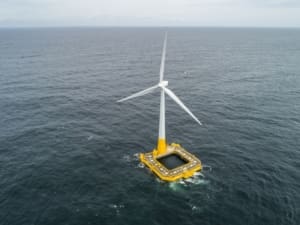Looking ahead
So how does this look going into the future? Thanks to a global increase in offshore wind support, we have 1677 projects currently in development. Of these, 976 are bottom-fixed and 497 are floating: a 29.6% share, showing the potential of the energy capacity we can obtain further at sea.
Interestingly, the majority of projects do not specify their foundation types. We can predict with confidence that monopiles and jackets will dominate the fixed-bottom space, but with a variety of floating types gaining share, this market is harder to pin down.
Another interesting development is that we’ve reached the stage where floating technologies are advancing at a more accelerated rate than fixed technologies, increasing the maximum capacity of those projects. Soon, the maximum capacity of floating projects will overtake that of fixed-bottom. We might not want to call it a “tipping point,” given the connotations with these tall floating structures – but it’s something like that.
Looking at fully commissioned projects in development, the max capacity for floating is only 95MW, while fixed-bottom enjoys 1.4GW. For projects currently in construction, floating has 200MW maximum capacity and fixed-bottom has 1.5GW.
Rise of floating wind boosting project max capacity
Looking forward, it’s all change as the increased max capacity of floating projects starts to emerge. For in-development projects, grounded max capacity slows to 1.1GW, projects with a mix of floating and fixed turbines make up 1.7GW, and floating overtakes fixed with a massive 3.2GW. The reach is better, the wind is stronger further out in deeper waters, and the technology is on course to overtake the fixed-bottom orthodoxy.
It has been a tough year for the offshore wind sector, with no shortage of delayed projects caused by rising costs, supply chain issues and an unpredictable policy landscape. But at Taylor Hopkinson, every day in conversations with the market and our clients, we see a positive picture on the horizon.
From developers in Scotland and other markets driving forward pioneering floating projects to technology innovations that are boosting project capacity, we’re feeling pretty buoyant about the future.

